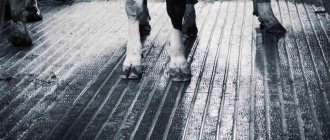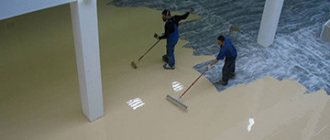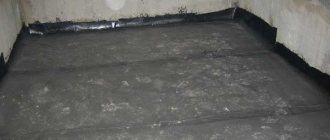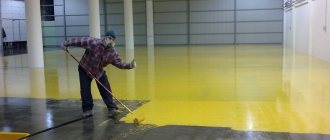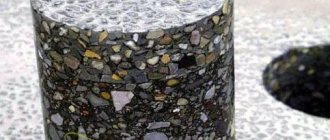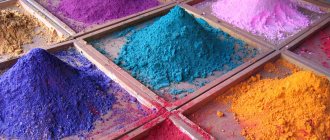When a concrete wall appears in the interior, it invariably attracts attention and becomes the main accent of the design. More recently, it was customary to hide such a base under finishing materials, but in the middle of the last century, many world-famous designers began to use such decor when implementing the concepts of modern styles. The article will discuss why this happened and how concrete is used today in the interiors of premises for various purposes.
Concrete is a fashionable finishing material Source offwallstreetwealth.com
Finishing walls, floors and ceilings
Walls
Concrete walls are a rather unusual way to decorate the interior of an apartment. In addition to pure concrete, there are several other options that give almost the same visual effect. For example, some types of plaster can be applied as a decorative part of the renovation.
The spatula mass is applied according to the same principle as plaster. A lot of different fractions are produced, which gives more opportunities for realizing ideas. Rolled concrete is easy to repair, and the thickness of the sheet reaches 5 mm. Concrete slabs and photo-printed wallpaper can recreate the desired texture and shade.
The photo shows a compact high-tech kitchen. The walls are finished with rolled concrete.
Ceiling
Concrete ceiling is suitable for finishing a modern interior. Gray color will make the room cold; lamps with warm light and wall decoration in a palette of warm shades will help to add coziness. A good idea would be to whitewash the concrete ceiling; the surface will retain its unique texture and make the room brighter. Clean mortar can be replaced with plaster and ceilings with photo printing.
Floor
A concrete floor will not warp due to moisture and will last for many years, but it will be very cold. In an apartment or house, it can be replaced with an imitation coating, such as linoleum, tiles or heated slabs.
Generalization on the topic
Don't be afraid to use rough finishes. The article showed how impressive, beautiful and stylish concrete walls look in the interior - how to treat them to extend the life of the finish is also very clear. Treatment with a hydrophobic composition and varnish is considered mandatory if there is a high humidity threshold in the room.
A little more attention!
Write in the comments what you think - such simplifications of design make it stricter and more beautiful, or is it better to look towards proven classics?
Texture
Rough
Grains of sand and small pebbles are clearly visible in the rough texture. Visually, the surface is matte, similar to velvet. In terms of tactile sensations, it is a hard, rough surface.
The photo shows a minimalist bedroom. Concrete walls have a rough texture.
Smooth
To give the surface a more finished look, several technologies are used.
- Polished concrete has a reflective surface in which all grains of sand and pebbles are visible. The mirror effect is achieved by mechanical grinding of the surface. For a stronger effect, the surface is polished.
- Varnished. A more cost-effective way to treat concrete surfaces. The surface becomes shiny and bright.
The 7th room, Sweden
Want to live in a treehouse? Thanks to the efforts of the Norwegian architectural agency Snøhetta, a childhood dream is finally coming true. On January 18, 2022, The 7th room hotel opened in a pine forest in northern Sweden, floating ten meters above the ground.
Panoramic windows allow guests to enjoy breathtaking views of the treetops of Lapland, the Lule River and the starry sky. Glass, iron and trees, merging together, turn the hotel into a secret refuge, where there is no place for vanity.
Natural concrete and its imitations
Clean concrete
- Structural concrete is used to construct the frame of monolithic buildings and floors. Main composition: cement, crushed stone, water, sand. The ratio of components is selected depending on their properties.
- Architectural concrete differs from construction concrete by additional additives, such as dyes, levelers, ceramic chips or glass. This composition is used for interior decoration, such as walls, bar counters or fireplaces.
Imitation concrete
The same visual effect can be achieved using other finishing methods. Using various materials you can choose the desired color, pattern and texture.
- Wall panels. Gypsum panels have a number of advantages: they are lighter than concrete, cheaper and the range of models is much wider. In addition, the panels are much easier to work with, and they look no less impressive.
- Plaster. There are several types: lime and marble plaster. Lime plaster filters the air and is suitable for allergy sufferers. Marble flour contains flour from marble, gypsum and lime. The visual effect can be matte or glossy.
- Spatula mass is a strong elastic composition that interacts well with moisture. The spatula mass can have a different composition, from fine-grained with inclusions to coarse-grained.
- Rolled concrete, wallpaper and photo wallpaper. Rolled concrete is a flexible web consisting of mineral flour up to 5 mm thick. Applied to the wall using special glue. Wallpaper and photo wallpaper are perhaps one of the simplest methods of decoration. Photo printing can accurately imitate a pattern.
The photo shows a bright bedroom in a modern style. The wall decoration is made using photo wallpaper.
- Tiles are another way to stylishly decorate your interior. Wide tiles with imitation concrete can decorate a kitchen, hallway, or restroom.
- Imitation painting. Not the easiest way, but the most creative. The prepared polished surface can be painted, repeating the patterns of a real concrete slab.
Surface preparation
Before applying the plaster, the surface surface is pre-prepared. The solution adheres better to the mineral surface of substrates, such as: cement, drywall, concrete, gypsum, etc. The material itself has high adhesion, but if you use the same primer (highly adhesive), the solution will even stick to glass and will be on it hold on.
To work with art concrete, the wall surface must be clean, uniform and dry. If it is not, then it needs to be cleaned and leveled. Remove all old peeling coatings and weak elements. Then cracks, holes, and other defects are sealed with putty. The canvas is sanded. Dust and debris are carefully removed.
Decoration of rooms in the apartment
Kitchen
In the kitchen, concrete mortar can be used on almost any surface. Walls, floors or ceilings made of concrete will set the character of the interior; the surface can be rough and untreated or, conversely, have a glossy surface. The latter option is suitable for small kitchens; it will seem more spacious due to its reflective properties.
The countertop or the whole island can also be concrete. The surface is heavy, but durable and reliable; it will look very impressive in the interior.
The photo shows the kitchen of a country house. The set and island are completely made of concrete.
Concrete mortar can also be used in small details, such as hanging shelves, a kitchen apron or a small stove above the dining area.
Living room
In addition to the main surfaces: floor, walls and ceiling, decorative elements, tables or TV stands can be concrete.
In a studio apartment, a concrete column or partition will help divide the room into zones.
Concrete panels can become part of the fireplace; the contrast of fire and stone will look beautiful in the overall picture.
Bedroom
In order not to deprive the design of comfort, it is worth using concrete in the interior in doses. For example, decorate one of the walls or make a headboard for the bed.
The photo shows a bedroom in the attic. Despite the wall decoration with photo wallpaper imitation concrete, the interior is light and delicate.
Children's
Don't deprive your children's room of joy and bright colors with gray walls. If desired, materials that imitate concrete can be partially used in interior decoration, for example, photo wallpaper that replicates the texture.
Bathroom and toilet
Current material for finishing the bathroom. Concrete walls look harmonious with glass partitions. A cast countertop with a polished concrete sink will decorate a spacious bathroom.
The photo shows a massive sink on a wooden countertop. The faucet and sink are made in the same style.
Hallway
A good interior solution would be to combine it with other materials, such as wood or brick. The decoration of one of the walls will look harmonious. For a compact room, you can use a varnished floor.
The photo shows a compact hallway. The wall decoration is made of brickwork and putty wood.
How to make decorative plaster for concrete with your own hands
It’s better, of course, to buy ready-made plaster in a store, but you can manage to make it yourself. Building materials you will need: cement mixture and acrylic paints. To perform simple texture and coloring, these materials are quite enough. Select the desired option and intensity of paint by eye and at your own discretion.
If you want to take a step further in the experimental part, then we make the solution ourselves. Here is the plaster recipe:
- 1 part of cement at least M400, if you take white, it is easier to paint;
- water (2 parts);
- textured filler - 3 parts (quartz sand, marble or granite chips, tiny crushed stone.
The components are thoroughly mixed until the composition is homogeneous. Pay special attention to this.
Unmixed lumps in the solution will greatly reduce its quality.
Well, the composition is mixed to perfection, there are no lumps. Art concrete “Do it yourself” is ready. Feel free to get to work.
Photo in the interior of a country house
The interior of a country house has more opportunities for realizing ideas. A simple fireplace with a concrete cladding will look gorgeous. The contrast of cold and hot will look impressive in the interior of the living room.
The photo shows a living room in the interior of a country house. The niche, finished with concrete panels, is fully utilized, combining a fireplace, a seating area and a place for logs.
With the help of concrete columns or small partitions, you can divide the space into zones without compromising the area, without interfering with natural light.
A minimalist staircase with railings is suitable for both classic and modern interiors.
Cabin Vindheim, Norway
Inspired by the sight of snow-covered houses, Norwegian architecture studio Vardehaugen, led by architect Matre Aasarød, showed off their vision of the perfect winter retreat.
The design of the house allows you to blur the boundaries between nature and architecture. Thus, in winter, the roof of the house turns into a springboard for ski jumping, tubing and active games.
Combination with other finishing materials
- With a tree. Combining with wood will make the interior warmer, it will soften the cold material. A similar solution is suitable for a room in country, loft, or eco-style.
- Brick. Brick and concrete look harmonious together. An ideal combination for a loft interior. Depending on the color of the brick, the room will be cold or warm.
- Glass. The combination creates a strict and brutal interior. Glass can serve as a partition, protection or decorative addition. Glass on top of a concrete wall will provide a reflective surface, which will visually increase the area and look interesting in the overall picture.
- Metal. Metal and chrome surfaces will continue the stylistic idea. An ideal combination for hi-tech and loft style.
Cladding panels
Docke EDEL plinth panel, corundum
Working length: 945 mm Working width: 400 mm Working area: 0.38 sq.m Profile height: 15 mm
Docke EDEL plinth panel, rhodonite
Working length: 945 mm Working width: 400 mm Working area: 0.38 sq.m Profile height: 15 mm
Docke EDEL plinth panel, beryl
Working length: 945 mm Working width: 400 mm Working area: 0.38 sq.m Profile height: 15 mm
Docke EDEL plinth panel, zircon
Working length: 945 mm Working width: 400 mm Working area: 0.38 sq.m Profile height: 15 mm
Facade panel Docke FLEMISH, burnt red
Working length: 1095 mm Working width: 420 mm Working area: 0.46 sq.m Profile height: 17.4 mm
Facade panel Docke FLEMISH, burnt yellow
Working length: 1095 mm Working width: 420 mm Working area: 0.46 sq.m Profile height: 17.4 mm
Facade panel Alta-profile, White stone
Working length: 1010 mm Working width: 450 mm Working area: 0.46 sq.m
Docke STEIN facade panel, basalt
Working length: 1098 mm Working width: 400 mm Working area: 0.44 sq.m Profile height: 25 mm
Docke STEIN façade panel, anthracite
Working length: 1098 mm Working width: 400 mm Working area: 0.44 sq.m Profile height: 25 mm
Facade panel YAFASAD Catherine stone, amber
Working length: 1322 mm Working width: 294 mm Working area: 0.39 sq.m Panel height: 22 mm
Facade panel YAFASAD Demidov brick, amber
Working length: 1475 mm Working width: 306 mm Working area: 0.42 sq.m Panel height: 22 mm
Facade panel YAFASAD Rock, ivory
Working length: 1476 mm Working width: 312 mm Working area: 0.46 sq.m Panel height: 22 mm
Working length: 945 mm Working width: 400 mm Working area: 0.38 sq.m Profile height: 15 mm
Working length: 945 mm Working width: 400 mm Working area: 0.38 sq.m Profile height: 15 mm
Working length: 945 mm Working width: 400 mm Working area: 0.38 sq.m Profile height: 15 mm
Working length: 945 mm Working width: 400 mm Working area: 0.38 sq.m Profile height: 15 mm
Working length: 1095 mm Working width: 420 mm Working area: 0.46 sq.m Profile height: 17.4 mm
Working length: 1095 mm Working width: 420 mm Working area: 0.46 sq.m Profile height: 17.4 mm
Working length: 1010 mm Working width: 450 mm Working area: 0.46 sq.m
Working length: 1098 mm Working width: 400 mm Working area: 0.44 sq.m Profile height: 25 mm
Working length: 1098 mm Working width: 400 mm Working area: 0.44 sq.m Profile height: 25 mm
Working length: 1322 mm Working width: 294 mm Working area: 0.39 sq.m Panel height: 22 mm
Concrete furniture
You can make interesting coffee tables with a concrete base or tabletop, minimalist chairs, shelves and TV stands. The furniture will be heavy, but unusual.
For heavy interior items, this could be a kitchen countertop or an island; the material is reliable and durable. For the bathroom, you can make a concrete countertop with a sink.
Company Services
Our company is ready to implement such ventilated facade solutions at the best price, taking into account the technical documentation and regulations for the installation of the system in accordance with the norms and rules of the Ministry of Construction. We offer to order the following services from us:
- Development of project documentation
- Selection of façade design with concrete tiles
- Installation of facade systems
- Testing
- Installation
- Sale of facing materials
- Supervised installation
vote
Article rating
Decor and accessories
Concrete or plaster decorative elements will be an interesting addition to the interior. These can be floor or tabletop potted vases, unusual flower vases, decorative items, book holders or massive candlesticks.
Panel marking
In order to understand the marking of concrete or reinforced concrete products, you should consider one of them as an example. The most common brand of plate is PST 63.18.2.5-TP-11/12. It is intended for the construction of industrial buildings and is three-layer.
The first three letters indicate the type of panel and its dimensions. In this case, it is PST - a three-layer wall panel. The second letter fragment indicates the class and type of concrete. In this case, heavy concrete was used in the production process. Lightweight and cellular concrete are designated by the first letters of the words - L and Y.
Matching Styles
Loft
This is the first thing you can associate with when mentioning concrete pavement. The style is characterized by the absence of decorative trim. Brickwork and concrete slabs look harmonious in a duet.
Minimalism
A minimalist furnished room with concrete finishing will look impressive. A few bright details will complete the interior, such as a bright poster or bedspread.
Grunge
The style is similar to loft, but has a number of differences. Grunge is more elegant and “loves” natural materials. The interior will be complemented by elegantly shaped furniture and cotton or linen textiles.
The photo shows a living room in grunge style. The interior is filled with furniture made from natural materials.
White desert camp, Antarctica
In the article South Pole: a luxury trip, we described a comfortable camp in the heart of Antarctica.
On the edge of the Schirmacher Oasis, approximately 2.8 km above sea level, lies the luxurious White Desert Camp, which consists of 6 “houses” designed by Ryan Ashworth.
Perhaps the White desert would not be so remarkable if it were not for its magnificent interior, which gives the camp discreet luxury and maximum comfort in the harsh conditions of Antarctica. Here you can relax on soft, low-slung leather furniture surrounded by thick, long-pile carpets. It is important to note that the furniture was created by one of the largest architects and furniture designers of the 20th century - Eero Saarinen.
How the coating is created
The work of arranging such floors is very similar to the usual leveling of the surface using a concrete screed. The work is essentially the same: pouring the rough base, drying and finishing filling with a leveling compound. At the final stage, concrete grinding is added using special equipment.
The mixtures that will be used for pouring are also very similar to commonly used solutions. The rough screed will generally be exactly the same. The differences will only be at the final stages of design: it is necessary to carefully compact the poured solution and cover it after sanding with a special impregnation, which gives the surface a shine.


